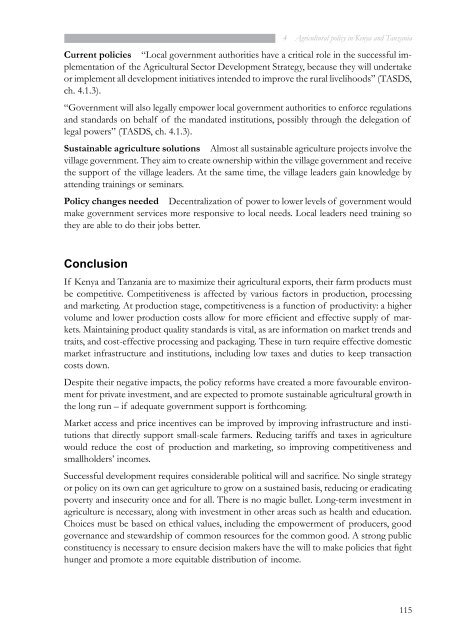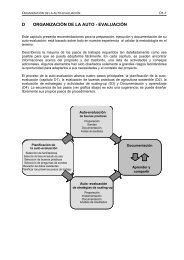cases from tanzania - Sustainet
cases from tanzania - Sustainet
cases from tanzania - Sustainet
You also want an ePaper? Increase the reach of your titles
YUMPU automatically turns print PDFs into web optimized ePapers that Google loves.
4 Agricultural policy in Kenya and Tanzania<br />
Current policies “Local government authorities have a critical role in the successful implementation<br />
of the Agricultural Sector Development Strategy, because they will undertake<br />
or implement all development initiatives intended to improve the rural livelihoods” (TASDS,<br />
ch. 4.1.3).<br />
“Government will also legally empower local government authorities to enforce regulations<br />
and standards on behalf of the mandated institutions, possibly through the delegation of<br />
legal powers” (TASDS, ch. 4.1.3).<br />
Sustainable agriculture solutions Almost all sustainable agriculture projects involve the<br />
village government. They aim to create ownership within the village government and receive<br />
the support of the village leaders. At the same time, the village leaders gain knowledge by<br />
attending trainings or seminars.<br />
Policy changes needed Decentralization of power to lower levels of government would<br />
make government services more responsive to local needs. Local leaders need training so<br />
they are able to do their jobs better.<br />
conclusion<br />
If Kenya and Tanzania are to maximize their agricultural exports, their farm products must<br />
be competitive. Competitiveness is affected by various factors in production, processing<br />
and marketing. At production stage, competitiveness is a function of productivity: a higher<br />
volume and lower production costs allow for more efficient and effective supply of markets.<br />
Maintaining product quality standards is vital, as are information on market trends and<br />
traits, and cost-effective processing and packaging. These in turn require effective domestic<br />
market infrastructure and institutions, including low taxes and duties to keep transaction<br />
costs down.<br />
Despite their negative impacts, the policy reforms have created a more favourable environment<br />
for private investment, and are expected to promote sustainable agricultural growth in<br />
the long run – if adequate government support is forthcoming.<br />
Market access and price incentives can be improved by improving infrastructure and institutions<br />
that directly support small-scale farmers. Reducing tariffs and taxes in agriculture<br />
would reduce the cost of production and marketing, so improving competitiveness and<br />
smallholders’ incomes.<br />
Successful development requires considerable political will and sacrifice. No single strategy<br />
or policy on its own can get agriculture to grow on a sustained basis, reducing or eradicating<br />
poverty and insecurity once and for all. There is no magic bullet. Long-term investment in<br />
agriculture is necessary, along with investment in other areas such as health and education.<br />
Choices must be based on ethical values, including the empowerment of producers, good<br />
governance and stewardship of common resources for the common good. A strong public<br />
constituency is necessary to ensure decision makers have the will to make policies that fight<br />
hunger and promote a more equitable distribution of income.<br />
115




